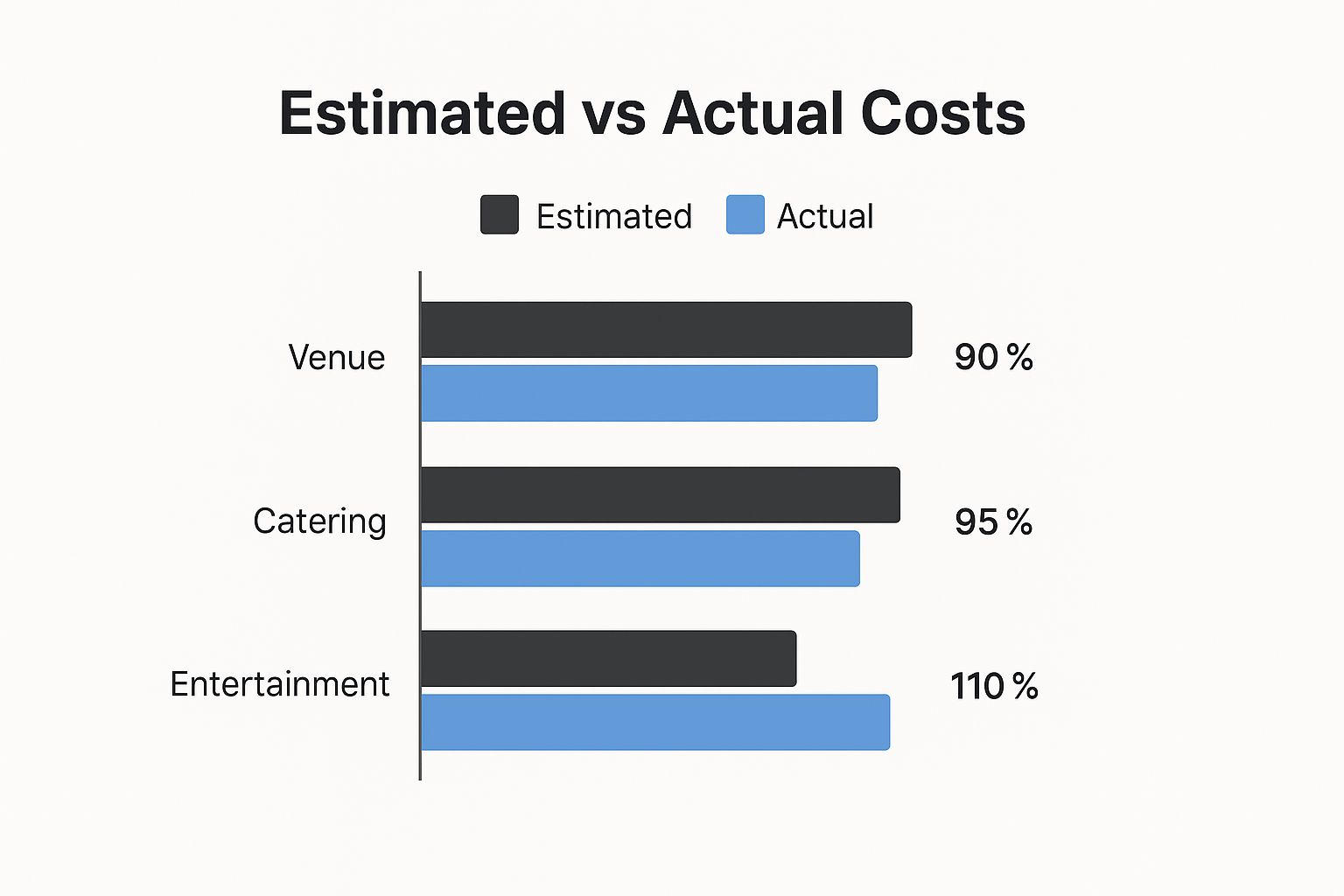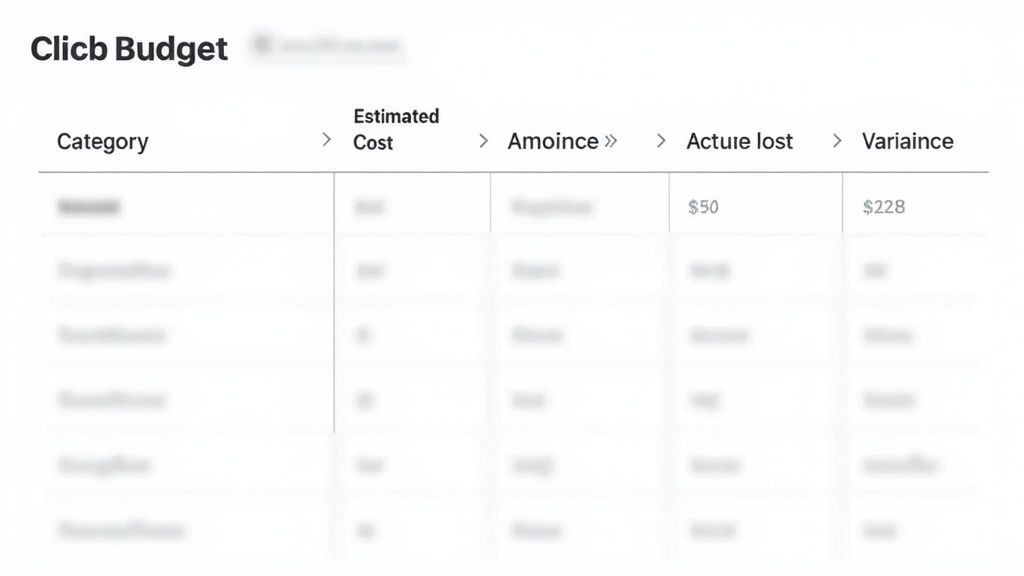Event Planning Budget Template for Conference Success
Use our event planning budget template to master your conference finances, attract sponsors, and maximize ROI. Get practical insights from industry data.
An effective event planning budget template is more than a list of expenses. For conference organizers, it’s a strategic financial roadmap that ensures every dollar spent aligns with your core objectives—attracting the right attendees and, crucially, locking in high-value sponsorships.
As the largest aggregator of conference and sponsor data, we see firsthand how the most successful events leverage their budgets not just to control costs, but to build a compelling case for sponsors.
Building Your Conference Budget From the Ground Up
Before booking a keynote speaker or reaching out to a single sponsor, your conference needs a solid financial foundation. This isn't just about crunching numbers; it's about creating a dynamic model that mirrors your primary goals. Is your aim to deliver an unforgettable attendee experience that sponsors will want to be part of? Or is your focus on proving clear, measurable value to potential partners?
Understanding how to build effective financial models is a game-changer for this kind of robust planning. Forecasting costs without historical data can feel like a guess, but it’s entirely doable if you lean on industry data. The trick is to start with the largest, most critical categories first.
Forecasting Major Expenses
For most conferences, your biggest financial commitments will be the venue and catering. These two elements don't just consume the budget; they fundamentally shape the experience for everyone involved, from attendees to the sponsors trying to reach them.
Our data consistently shows that, on average, a staggering 65% of corporate conference budgets go directly to these two areas. The average spend per attendee often lands somewhere between $150 to $169 per day. This data gives you a powerful starting point. By looking at similar conferences in your niche, you can create a reliable baseline for your own projections.
A great way to find comparable conferences and gauge their scale is by exploring a comprehensive database.
A budget isn't just an accounting tool—it's a narrative that tells the story of your conference's value. Every line item should answer the question: "How does this investment contribute to a better experience for attendees and a higher ROI for sponsors?"
To get you started, here's a look at the core budget categories you'll need to account for.
Core Conference Budget Categories Breakdown
This table summarizes the essential budget buckets for nearly any conference. Think of it as your starting framework, with examples of specific line items you'll want to include under each primary category.
| Primary Category | Example Line Items | Average % of Total Budget |
|---|---|---|
| Venue | Main hall rental, breakout rooms, A/V equipment, Wi-Fi, insurance | 25-30% |
| Catering | Coffee breaks, lunch, evening reception, staff meals | 30-35% |
| Marketing | Digital ads, social media, content creation, email marketing | 10-15% |
| Speakers | Keynote fees, travel, accommodation, honorariums | 5-10% |
| Technology | Event app, registration platform, virtual streaming services | 5-8% |
| Staff & Ops | On-site staff, security, signage, administrative costs | 5-7% |
This breakdown isn't set in stone, but it provides a solid foundation for allocating your funds effectively from day one.
Visualizing Your Spending
Keeping a close eye on your estimated costs versus what you actually spend is absolutely essential for maintaining financial control. The chart below shows a common scenario where catering costs creep up past the initial estimate, while the venue expenses hold steady.

This kind of visual makes it crystal clear why a contingency fund is non-negotiable. Unexpected jumps in variable costs like food and beverage happen all the time. From here, you can structure your budget template to bake in these potential swings, making sure you're prepared for the realities of running the conference.
Unlocking Sponsorship Dollars Through Your Budget
Your conference budget is so much more than a spreadsheet of expenses. When you present your plan to a potential sponsor, they see your entire strategy. They’re not just scrutinizing costs; they're looking for proof that you’ve built a platform that will help them hit their marketing targets.
Think of every line item as an investment in the attendee experience—and that experience is precisely what sponsors are paying to access. Smart, intentional spending turns your budget from a cost center into a powerful sales tool, unlocking major sponsorship revenue.
Venue and Catering: More Than Just Overhead
It's easy to see venue and catering as the two biggest money pits in your budget. That's a huge mistake. A great venue in a convenient location isn't just a place to hold your conference; it's a premium backdrop for sponsor activations and a signal of quality to attendees.
Upgrading your venue to one with dedicated networking lounges or private meeting rooms? Those aren't costs—they're monetizable assets. You can sell those spaces as exclusive sponsorship packages.
The same logic applies to catering. Don't just feed people; create experiences. A barista-staffed coffee bar or a sponsored happy hour might seem like frills, but they're investments in creating the exact kind of environment where business gets done. Sponsors will happily pay for that.
Stop thinking about minimizing costs and start thinking about maximizing value. A sponsor will gladly fund a premium networking reception if they see it as the best way to get face-time with C-level attendees.
Turning Tech Investments into Sponsorship Tiers
Technology is another area where spending a little more can yield huge returns. Funneling more of your budget into high-quality live streaming or a robust event app doesn't just make for a better virtual experience; it opens up a whole new inventory of digital sponsorships you can sell.
Here’s how a simple tech investment can directly translate into sponsor revenue:
- Branded Virtual Lobbies: Give a top-tier sponsor the naming rights to the virtual platform’s main lobby. Their brand becomes the first thing every single online attendee sees.
- Sponsored Session Recordings: Find a sponsor for the on-demand content. This gives their brand incredible long-tail visibility for months after the conference wraps.
- Interactive App Features: That investment in an event app with live polling and Q&A? A sponsor who wants to engage the audience and capture lead data will see that as a golden opportunity.
Our data shows that conferences with strong digital components often create new, high-margin revenue streams. A mid-sized tech conference added $15,000 to its A/V budget for professional streaming. They then sold a "Digital Main Stage" sponsorship package for $40,000, with branded video overlays and pre-roll ads. That single move created a $25,000 net gain and delivered massive value to their partner.
Your Marketing Spend is a Sales Tool
Finally, don't forget that your marketing budget is a direct investment in your sponsors' success. A well-funded marketing plan shows you’re serious about getting the right people in the room—the exact people your sponsors want to meet.
When you can walk into a pitch meeting and show a potential sponsor detailed analytics on your attendee acquisition strategy, you’re not just asking for a check. You're proving you can deliver a qualified audience. In that moment, your budget becomes the ultimate proof of your conference's value.
Weaving Sponsorship Revenue into Your Budget
For most successful conferences, sponsorships aren't just a bonus—they're the financial backbone. Yet many organizers treat this revenue as an afterthought. A much savvier approach is to build your projected sponsorship income directly into your event budget template from day one.
When you do this, your budget stops being a static list of costs and becomes a dynamic sales and forecasting tool. Instead of just listing what you're spending, you can strategically tie specific, high-impact expenses to tangible sponsorship opportunities. This gives your team clarity and helps you build a compelling story for potential partners. Imagine telling a sponsor their investment will directly fund the high-speed Wi-Fi attendees rely on. The value becomes instantly obvious.

Building Sponsorship Tiers Right into Your Template
Your budget template needs a dedicated section for sponsorship revenue, broken down into tiers that correspond directly to your major line-item expenses. This creates a powerful, logical link between what a sponsor gives you and what they get in return.
Start thinking about your big-ticket budget items and how they can be monetized. It’s a creative process that pays dividends. For example:
- Tech Costs: That big investment in a slick event app? Offset it by creating a "Presenting App Sponsor" package. Their logo on the splash screen and sponsored push notifications make for a high-value offer.
- Catering Bills: The networking reception is prime sponsorship real estate. The entire cost of food and drinks can be covered by one exclusive "Reception Sponsor."
- Venue Perks: Even smaller costs can become revenue streams. Those charging stations everyone flocks to? That's a perfect micro-sponsorship, offering an accessible price point for smaller companies.
This method makes your sponsorship packages feel less random and more grounded in the real costs of producing a standout conference. It also makes your revenue forecasting far more accurate.
Let Data Drive Your Sponsorship Pricing
As the largest aggregator of conference data, we see a clear pattern: the most successful events use data to price their sponsorships, not guesswork. Don't just pull a number out of thin air for a keynote sponsorship. You need to analyze comparable conferences to understand the market rate.
Looking at the sponsorship decks for an event like the 2025 Joint Meeting can give you invaluable benchmarks to inform your own pricing strategy.
Your budget shouldn't just track money; it should demonstrate value. When a sponsor sees that their $20,000 investment covers the entire cost of the live-streaming production, the ROI becomes tangible, not abstract.
Understanding broader market trends is also essential. Our data reveals a fascinating split in event marketing strategies. A recent study found that 53% of organizations are funneling more money into sponsoring and attending conferences rather than hosting their own. This signals a strategic shift where companies want to tap into existing, engaged audiences.
This data tells a clear story: sponsors are actively searching for well-run platforms that deliver a specific, valuable audience. By structuring your budget to highlight targeted sponsorship opportunities, you’re positioning your conference as the perfect solution for their goals. You're no longer asking for a check; you're offering a data-backed partnership.
Keeping a Close Eye on Your Spending in Real Time
https://www.youtube.com/embed/ndFexNfakf8
Think of your event budget template as a living document. Its real power comes from using it as your financial command center. The line between a profitable conference that wows sponsors and one that quietly bleeds money often comes down to how closely you track expenses as they happen.
The goal here is to stay on top of your cash flow and avoid "budget creep," where small, unchecked expenses sink your bottom line. You don't need fancy software—a well-organized spreadsheet is enough. What you do need is the discipline to keep it updated.
Making Weekly Variance Checks a Habit
We can't stress this enough: conduct weekly variance checks. This is where you compare your "Actual Spend" column to your "Projected Spend" for every item. A little overage here or there might not seem like a big deal, but a few can snowball into a massive deficit.
Let's say your digital marketing costs jump by 15% two months out. A weekly check catches that spike immediately, giving you time to react. If you wait, you might not spot the overspend until it's far too late.
Real-time tracking isn’t just about accounting for money already spent. It’s about giving yourself the foresight to shift funds and make smart calls before a small leak becomes a flood. This is the kind of agility that sponsors expect to see.
Catching that marketing overspend early doesn’t mean disaster; it means you have options.
Making Smart Financial Pivots on the Fly
When a variance pops up, your budget template becomes your most important decision-making tool. You can see the entire financial picture and find places to make adjustments. Using our marketing overspend example, here’s how you could pivot:
- Talk to Your Vendors: Can you go back to your A/V provider and find some efficiencies? Maybe scale back elaborate lighting in breakout rooms to free up cash.
- Tweak a Variable Cost: Take a hard look at your catering. Switching from a plated lunch to a high-end buffet could cut service staff costs without cheapening the attendee experience.
- Get Creative with Sponsorships: Is there a gap you can fill? Offer a last-minute "Branded Wi-Fi" sponsorship. It’s a simple add-on that could bring in the exact amount needed to cover that unexpected marketing bill.
This hands-on approach to budget management shows you're fiscally responsible and thinking strategically—qualities that build trust with sponsors. When you can track every dollar, you can justify every decision with hard data.
Post-Event Analysis: Turning This Year's Data Into Next Year's Success

The doors have closed and the last guest has gone home. For many, the conference is over. For a savvy organizer, the real work is just beginning. This is where your budget template evolves from a tracking tool into a strategic blueprint for your next event, helping you prove ROI to sponsors and build a more profitable future.
Your first move should be a meticulous budget reconciliation. Go line by line, comparing your projected spend against your actual spend. Don't just look at the final numbers; dig into the "why." Did catering costs spike because of a surge in attendance, or did a vendor tack on an unexpected fee? Getting to the root cause of these variances is what separates good conference planners from great ones.
Finding Your Financial Wins and Sinking Ships
Once reconciled, your budget tells a compelling story. It clearly highlights what went right and what went wrong.
Maybe you blew past your sponsorship revenue goals. Fantastic! But which sponsorship tiers sold out first? What benefits did sponsors rave about? This isn't just a win; it's a road map showing you exactly what your partners value, giving you a powerful negotiating tool for next year.
On the flip side, spot the financial drains. Perhaps you invested heavily in elaborate directional signage that went ignored, or a marketing channel didn't deliver the ticket sales to justify the spend. Identifying these low-return investments is crucial. It frees up capital to be reallocated to areas that actually drive growth and sponsor value.
The goal of a post-event analysis isn't to second-guess past decisions. It's about making smarter ones in the future. Every dollar you track today helps build a more resilient and attractive budget for tomorrow.
Key Metrics That Prove Your Conference's Value
Now, translate your findings into a concise, data-driven report for your stakeholders and potential sponsors. Forget the fluff and focus on the numbers that demonstrate success and guide future strategy.
- Final Cost Per Attendee: This is your benchmark. Divide your total event cost by the final attendee count. Tracking this year-over-year is one of the clearest indicators of your conference's operational efficiency.
- Sponsorship Revenue vs. Total Cost: What percentage of the conference's total expenses was covered by sponsors? This metric directly showcases the financial viability of your conference and its appeal to partners.
- Profit/Loss by Revenue Stream: Get granular. Did your success come from ticket sales, or was it the high-margin sponsorships that carried the day? Knowing this tells you where to double down on your sales and marketing efforts.
This level of analytical rigor is no longer optional. The global conference and events industry is on a steep growth trajectory. To claim your piece of that pie, you need a data-first mindset. By treating your post-event analysis as the first step in planning your next conference, you create a cycle of continuous improvement that makes each event more successful—and more sponsor-friendly—than the last.
Common Questions About Conference Budgeting

After analyzing data from thousands of conference budgets, we see the same questions pop up time and again. These aren't just theories; they're practical, data-backed insights to help you build a financially sound conference that sponsors will line up to be a part of.
What Is the Biggest Mistake to Avoid When Creating a Conference Budget?
Without a doubt, the single most damaging mistake is failing to build in a contingency fund. We’ve seen it happen too many times. Even the most perfectly planned conference is guaranteed to have surprises. Maybe your A/V supplier needs extra gear, or you need more temp staff to handle registration.
Without that financial cushion, you're left scrambling. This often means cutting corners on things that directly impact the attendee experience—the very thing your sponsors are paying for.
Pro Tip: Set aside 10-15% of your total estimated costs for a contingency fund from the start. A smart budget doesn't just plan for what you know will happen; it prepares you for what could happen.
How Can I Use My Budget to Attract Better Sponsors?
Think of your budget as one of your most powerful sales tools. The days of generic "Gold, Silver, Bronze" packages are fading. Sponsors want to see exactly where their money is going and what kind of impact it will have.
Instead of just asking for a check, offer them the chance to own a specific, high-visibility piece of the conference. Frame the conversation around a tangible outcome. A sponsor isn't just giving you $15,000; they are hosting the opening night networking reception, getting exclusive branding and direct access to attendees in a high-energy environment.
This simple shift changes the dynamic. You’re no longer asking for money; you’re offering a strategic partnership with a clear, measurable return.
Here are a few ways we’ve seen this work brilliantly in our data:
- Wi-Fi Sponsorship: A $5,000 investment can cover the venue's Wi-Fi cost, putting the sponsor’s brand on a custom login page and password.
- Keynote Stage Sponsorship: Cover your top speaker's fee and stage production costs with a premium package that gives a sponsor prominent branding on the main stage.
- Event App Sponsorship: Let a sponsor cover the entire cost of your mobile app in exchange for their logo on the splash screen every time an attendee opens it.
When you tie a sponsorship directly to a line item, the ROI becomes incredibly clear.
What Percentage of a Conference Budget Should Go to Marketing?
Our data suggests a good rule of thumb is to allocate 15-20% of your total conference budget to marketing and promotion. But this isn't set in stone.
If you're launching a brand-new conference, you might need to push that closer to 25% to build awareness from scratch. A well-established conference with a loyal following might be able to allocate less.
The key is to be religious about tracking your spend against ticket sales and sponsorship leads. This data is your best friend. It helps you calculate the ROI of each marketing channel—from social media ads to email campaigns—and prove to sponsors that your promotional efforts are directly driving revenue by bringing the right people to the event.
Ready to find the perfect sponsors for your next conference? At ConferenceDatabase, we provide the most detailed data on sponsorship revenue, attendee counts, and quality metrics for thousands of events. Sign up today to identify high-value opportunities and make data-driven decisions that maximize your ROI.